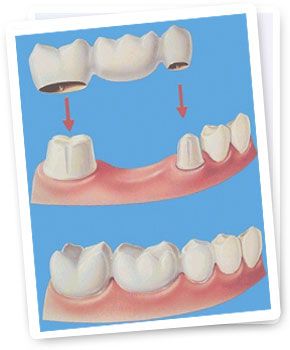Crown and Bridges
Sometimes a tooth - or teeth - need to be reinforced to protect what part of them is still healthy and strong. This may be the case when a tooth has a lot of filling material and decay has set in under the filling. Or, perhaps the tooth has been injured in some way and needs to be rebuilt. In situations such as these, crowns - or caps, as they are also called - are used to cover what remains of the tooth.
How do Crowns Work?
A crown is used to entirely cover or "cap" a damaged tooth. Besides strengthening a damaged tooth, a crown can be used to improve its appearance, shape or alignment. A crown can also be placed on top of an implant to provide a tooth-like shape and structure for function. Porcelain or ceramic crowns can be matched to the colour of your natural teeth. Other materials include gold and metal alloys, acrylic and ceramic. These alloys are generally stronger than porcelain and may be recommended for back teeth. Porcelain bonded to a metal shell is often used because it is both strong and attractive.
Your dentist may recommend a crown to:
- Replace a large filling when there isn't enough tooth remaining
- Protect a weak tooth from fracturing
- Restore a fractured tooth
- Cover a dental implant
- Cover a discoloured or poorly shaped tooth
- Cover a tooth that has had root canal treatment
What is a bridge?
A bridge is a dental appliance that replaces one or more natural missing teeth, thereby "bridging" the space between two teeth. Fixed bridges are cemented into place next to the "abutment" teeth--the surrounding teeth on either side of the space, or "span." Unlike removable partial dentures, fixed bridges cannot be taken out of the mouth by the patient.
A fixed bridge is a device that typically consists of three units -- a pontic (a false tooth) fused between two crowns that are cemented onto the abutment teeth.
Who should get a bridge?
If you are missing any teeth and are committed to maintaining good oral hygiene practices, you may be a good candidate for a bridge. A bridge is the most natural choice to fill the space in your mouth left by missing teeth. If left unfilled, this space can cause the surrounding teeth to drift out of position and can cause teeth and gums to become more susceptible to tooth decay and gum disease that can cause further tooth loss. Fixed bridges not only correct an altered bite, improve your chewing ability and speech, but they also safeguard your appearance by preventing the collapse of your facial features that can cause premature wrinkles and age lines. Careful consideration must also be given to using dental implants to replace missing teeth, as they provide a key benefit of not using natural teeth for support.
What procedures are involved?
For a traditional fixed bridge, the first appointment consists of the dentist reducing the adjacent abutment teeth that will act as anchors. Impressions are made, from which a metal framework, including the pontic, is created. By the second appointment, the final bridge is fitted over the teeth.
The total treatment time is usually between two or four weeks, depending on the type of bridge.
How do I care for a bridge?
With a bridge, it is more important than ever to brush, floss and see your dentist regularly. If you do not control the buildup of food debris and plaque -- the sticky film of bacteria formed from food acids -- your teeth and gums can become infected, requiring further treatment and resulting in possible loss of the bridge. Your dentist may also recommend using floss threaders that help remove bacteria from hard to reach spaces between the bridge and adjacent teeth and gums.
How long do crowns and bridges last?
While crowns and bridges can last a lifetime, they do sometimes have problems. The most important step you can take to ensure the longevity of your crown or bridge is to practice good oral hygiene. A bridge can lose its support if the teeth or bone holding it in place are damaged by dental disease. Keep your gums and teeth healthy by brushing with fluoride toothpaste twice a day and flossing daily. Also see your dentist and hygienist regularly for checkups and professional cleanings.
To prevent damage to your new crown or bridge, avoid chewing hard foods, ice or other hard objects.


